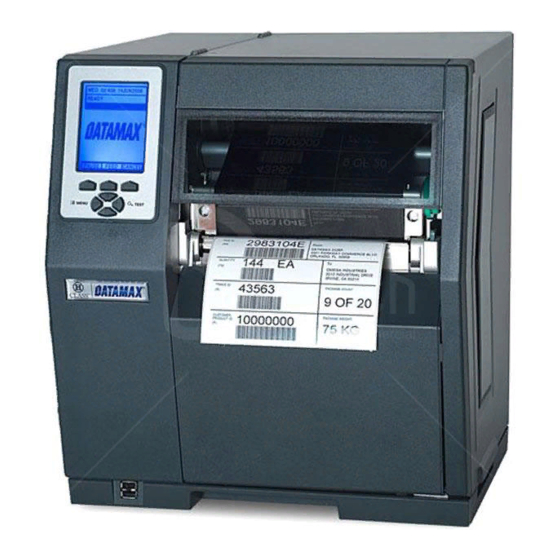Datamax H-Class 매뉴얼 - 페이지 6
{카테고리_이름} Datamax H-Class에 대한 매뉴얼을 온라인으로 검색하거나 PDF를 다운로드하세요. Datamax H-Class 8 페이지. Cutter option
Datamax H-Class에 대해서도 마찬가지입니다: 빠른 시작 매뉴얼 (12 페이지), 매뉴얼 (14 페이지), 매뉴얼 (10 페이지), 매뉴얼 (12 페이지)

To complete the setup, encoded data can be exported to a host device (with proper cabling) by enabling
OPTION FEEDBACK. The data is contained in the form <A;B;C;D;E;F>[CR] where:
A - Is the device type: R = RFID; and, S = Linear Scanner.
B - Is the status: C = entire label complete; F = faulted (failed) label; and, U = unknown.
C - Is the number of expected reads for bar codes or tags, given in two characters.
D - Is the number of good reads for bar codes or tags, given in two characters.
E - Is the printer's internal Job and Sub Job Identifier, given in four characters each.
F - Is the data that was read, delimited with semicolons (;) on multiple reads.
Enable OPTION FEEDBACK as follows:
1) Press MENU.
2) Using Scroll to COMMUNICATIONS then press ENTER.
3) Scroll to HOST SETTINGS then press ENTER.
4) Scroll to OPTION FEEDBACK then press ENTER.
5) Enter the desired output format (RFID HEX or RFID ASCII) then press ENTER.
6) Press EXIT; and, at the SAVE CHANGES prompt, press YES.
Step 3: Calibrate the RFID Tag
To establish the critical tag to transducer distance setting and nominal power requirements, the printer
features two different RFID tag calibration methods, Quick and Standard. As shown below, while the
amount of operator interaction differs, both calibration methods accomplish the same result. Before
calibrating ensure that
•
RFID media has been loaded;
•
The Media Sensor has been calibrated for the RFID media; and,
•
The RFID option has been enabled.
See the Operator's Manual for details. Proceed with the RFID Tag calibration by choosing your preferred
method and executing the steps required:
4
